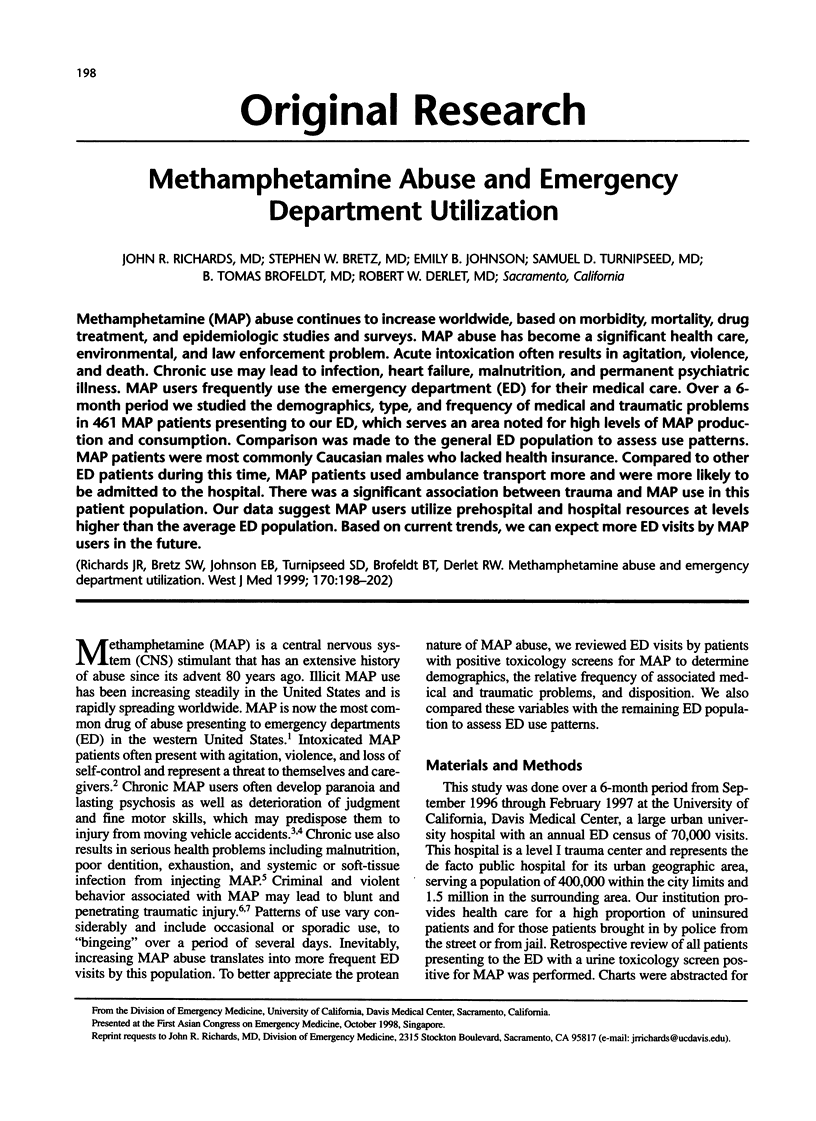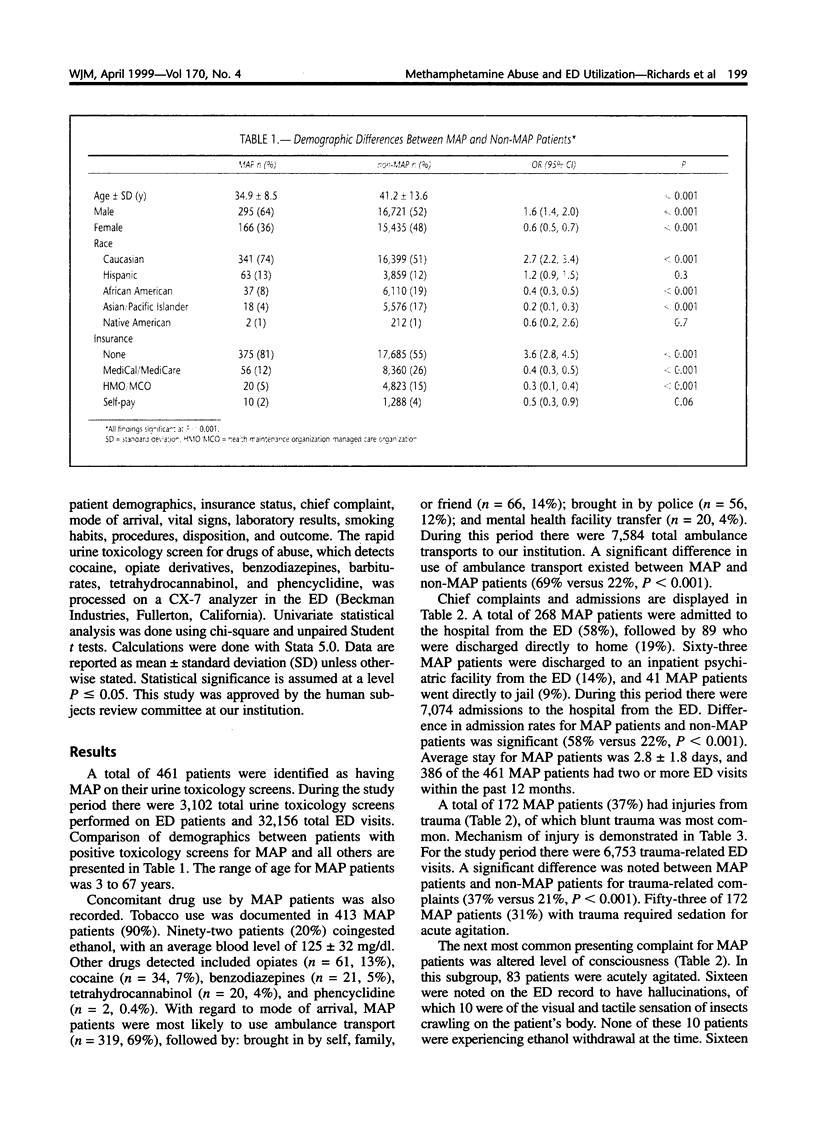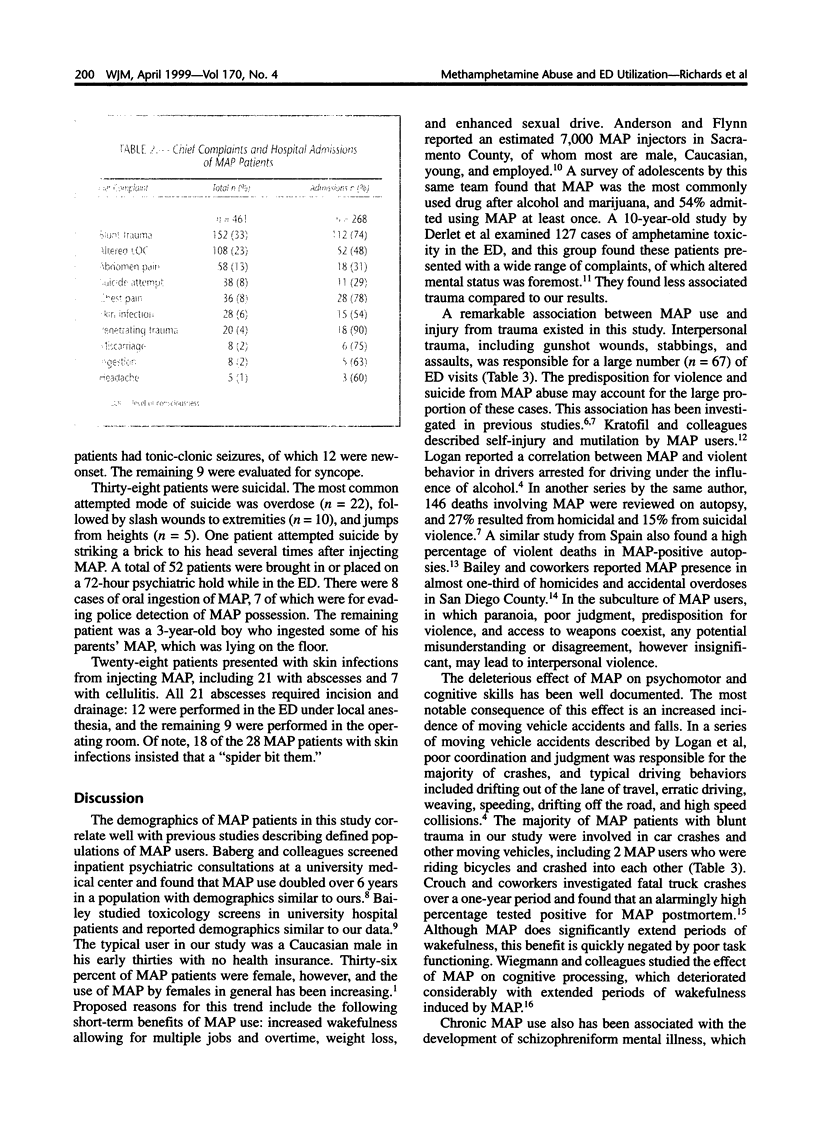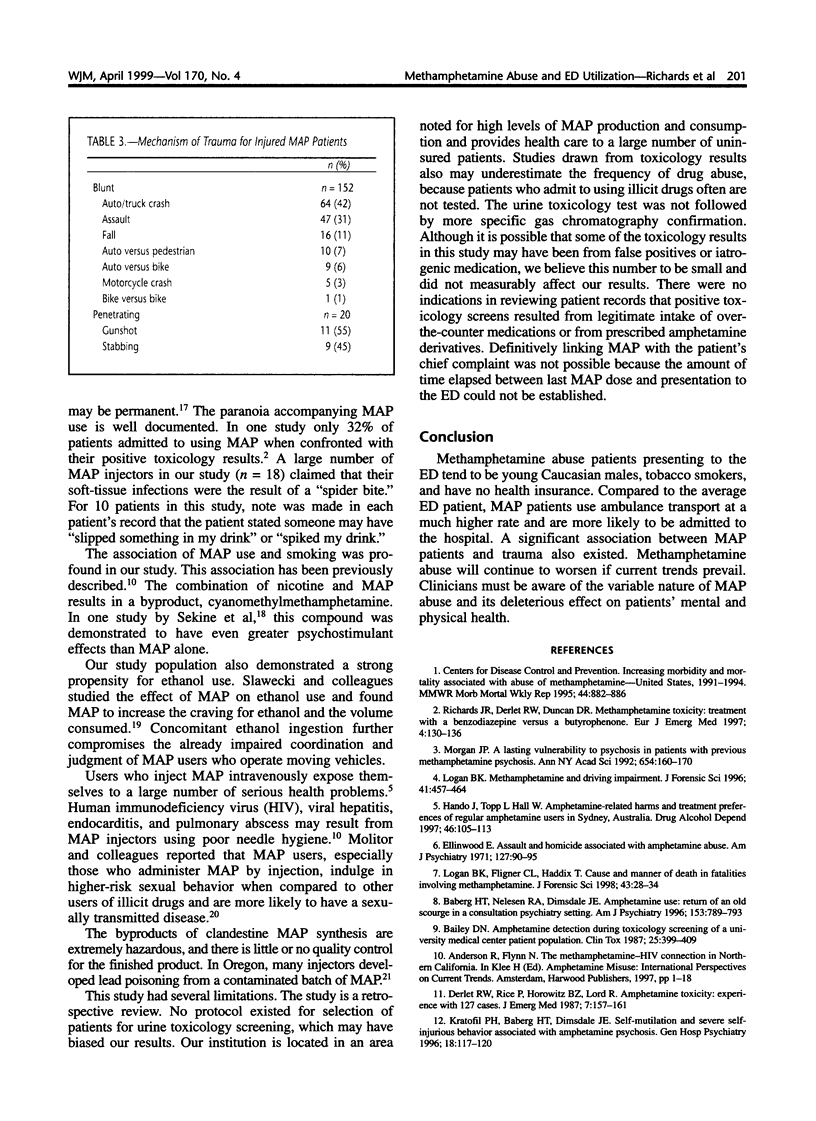Abstract
Methamphetamine (MAP) abuse continues to increase worldwide, based on morbidity, mortality, drug treatment, and epidemiologic studies and surveys. MAP abuse has become a significant health care, environmental, and law enforcement problem. Acute intoxication often results in agitation, violence, and death. Chronic use may lead to infection, heart failure, malnutrition, and permanent psychiatric illness. MAP users frequently use the emergency department (ED) for their medical care. Over a 6-month period we studied the demographics, type, and frequency of medical and traumatic problems in 461 MAP patients presenting to our ED, which serves an area noted for high levels of MAP production and consumption. Comparison was made to the general ED population to assess use patterns. MAP patients were most commonly Caucasian males who lacked health insurance. Compared to other ED patients during this time, MAP patients used ambulance transport more and were more likely to be admitted to the hospital. There was a significant association between trauma and MAP use in this patient population. Our data suggest MAP users utilize prehospital and hospital resources at levels higher than the average ED population. Based on current trends, we can expect more ED visits by MAP users in the future.
Full text
PDF




Selected References
These references are in PubMed. This may not be the complete list of references from this article.
- Baberg H. T., Nelesen R. A., Dimsdale J. E. Amphetamine use: return of an old scourge in a consultation psychiatry setting. Am J Psychiatry. 1996 Jun;153(6):789–793. doi: 10.1176/ajp.153.6.789. [DOI] [PubMed] [Google Scholar]
- Bailey D. N. Amphetamine detection during toxicology screening of a university medical center patient population. J Toxicol Clin Toxicol. 1987;25(5):399–409. doi: 10.3109/15563658708992642. [DOI] [PubMed] [Google Scholar]
- Bailey D. N., Shaw R. F. Cocaine- and methamphetamine-related deaths in San Diego County (1987): homicides and accidental overdoses. J Forensic Sci. 1989 Mar;34(2):407–422. [PubMed] [Google Scholar]
- Bell D. S. The experimental reproduction of amphetamine psychosis. Arch Gen Psychiatry. 1973 Jul;29(1):35–40. doi: 10.1001/archpsyc.1973.04200010020003. [DOI] [PubMed] [Google Scholar]
- Crouch D. J., Birky M. M., Gust S. W., Rollins D. E., Walsh J. M., Moulden J. V., Quinlan K. E., Beckel R. W. The prevalence of drugs and alcohol in fatally injured truck drivers. J Forensic Sci. 1993 Nov;38(6):1342–1353. [PubMed] [Google Scholar]
- Derlet R. W., Rice P., Horowitz B. Z., Lord R. V. Amphetamine toxicity: experience with 127 cases. J Emerg Med. 1989 Mar-Apr;7(2):157–161. doi: 10.1016/0736-4679(89)90263-1. [DOI] [PubMed] [Google Scholar]
- Hando J., Topp L., Hall W. Amphetamine-related harms and treatment preferences of regular amphetamine users in Sydney, Australia. Drug Alcohol Depend. 1997 Jun 6;46(1-2):105–113. doi: 10.1016/s0376-8716(97)00051-3. [DOI] [PubMed] [Google Scholar]
- Kratofil P. H., Baberg H. T., Dimsdale J. E. Self-mutilation and severe self-injurious behavior associated with amphetamine psychosis. Gen Hosp Psychiatry. 1996 Mar;18(2):117–120. doi: 10.1016/0163-8343(95)00126-3. [DOI] [PubMed] [Google Scholar]
- Logan B. K., Fligner C. L., Haddix T. Cause and manner of death in fatalities involving methamphetamine. J Forensic Sci. 1998 Jan;43(1):28–34. [PubMed] [Google Scholar]
- Logan B. K. Methamphetamine and driving impairment. J Forensic Sci. 1996 May;41(3):457–464. [PubMed] [Google Scholar]
- Lora-Tamayo C., Tena T., Rodríguez A. Amphetamine derivative related deaths. Forensic Sci Int. 1997 Feb 28;85(2):149–157. doi: 10.1016/s0379-0738(96)02095-6. [DOI] [PubMed] [Google Scholar]
- Molitor F., Truax S. R., Ruiz J. D., Sun R. K. Association of methamphetamine use during sex with risky sexual behaviors and HIV infection among non-injection drug users. West J Med. 1998 Feb;168(2):93–97. [PMC free article] [PubMed] [Google Scholar]
- Richards J. R., Derlet R. W., Duncan D. R. Methamphetamine toxicity: treatment with a benzodiazepine versus a butyrophenone. Eur J Emerg Med. 1997 Sep;4(3):130–135. doi: 10.1097/00063110-199709000-00003. [DOI] [PubMed] [Google Scholar]
- Sato M. A lasting vulnerability to psychosis in patients with previous methamphetamine psychosis. Ann N Y Acad Sci. 1992 Jun 28;654:160–170. doi: 10.1111/j.1749-6632.1992.tb25965.x. [DOI] [PubMed] [Google Scholar]
- Sekine H., Nagao S., Kuribara H., Nakahara Y. Behavioral effects of N-cyanomethylmethamphetamine, a product derived from smoking methamphetamine with tobacco, in mice and rats. Pharmacol Biochem Behav. 1997 May-Jun;57(1-2):167–172. doi: 10.1016/s0091-3057(96)00311-5. [DOI] [PubMed] [Google Scholar]
- Slawecki C. J., Samson H. H., Chappell A. Intranucleus accumbens amphetamine infusions enhance responding maintained by a stimulus complex paired with oral ethanol self-administration. Pharmacol Biochem Behav. 1997 Dec;58(4):1065–1073. doi: 10.1016/s0091-3057(97)00310-9. [DOI] [PubMed] [Google Scholar]
- Wiegmann D. A., Stanny R. R., McKay D. L., Neri D. F., McCardie A. H. Methamphetamine effects on cognitive processing during extended wakefulness. Int J Aviat Psychol. 1996;6(4):379–397. doi: 10.1207/s15327108ijap0604_5. [DOI] [PubMed] [Google Scholar]


